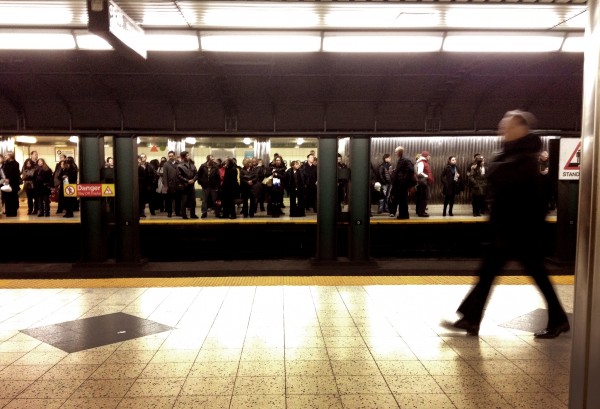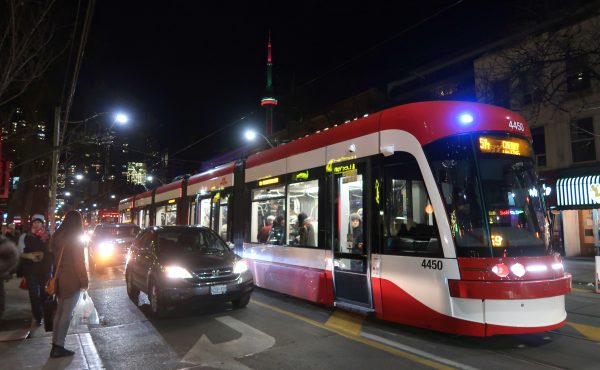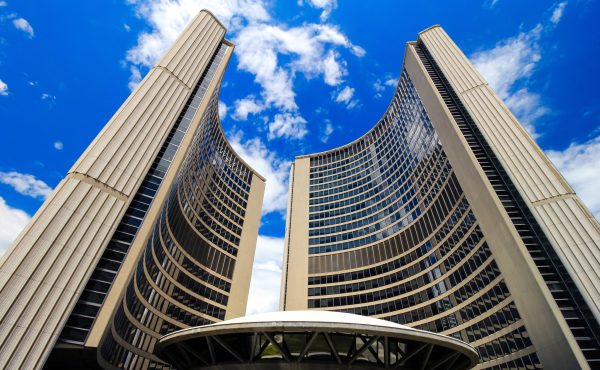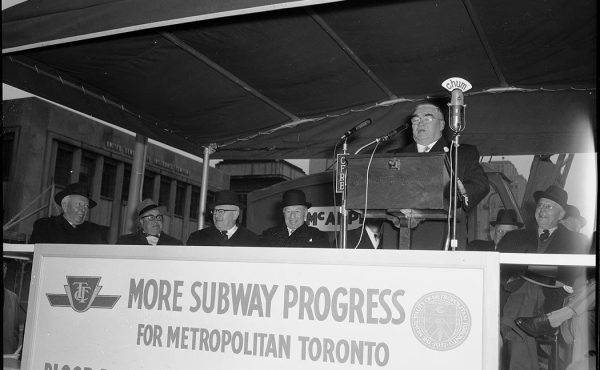If you have kids or once were one, you may have recognized the tactic that York Region’s politicians attempted last week when they scurried off to Ottawa to ask for their very own $4 billion subway.
That game of angles works like this: If one parent says no to the kid’s request, then try the other one, who’s known to be an easier mark and freer with the wallet.
A parenting problem in the world of adult public policy is a governance problem: the fact that York continues to lobby for the Yonge North subway extension reveals as much about Queen’s Park’s broken decision-making framework as its does about the scheme’s all-too-obvious transit planning flaws, about which much has been written.
Let me focus on the framework instead. When Metrolinx released its “Next Wave” project list in September 2013, as part of a Big Move monitoring report, the list included ten large rapid transit projects, including several 905 LRTs, GO electrification, the Yonge North line and the Relief Line.
In no particular order.
Metrolinx noted that the projects are “in the planning phase,” although none (at the time) had received funding. The agency had commissioned a “benefits case analysis” (BCA) for the Yonge North line (May 2013), and has since worked with City of Toronto and TTC planners on planning for the Relief Line.
The Yonge North BCA, produced by a consultant, is filled with all the usual economic analysis bafflegab – optimistic capital cost numbers, sunny predictions about ridership and land value capture, euphemisms about the “challenges” associated with the bottlenecks downstream…. The project, the report concludes, “is supported by a wealth of planning and policy documents beyond The Big Move.”
Maybe so, but in the three years since that BCA was released — a period during which the provincial Liberals pledged an additional $15 billion to GTA transit — neither Metrolinx nor the agency’s political masters have had anything specific to say about prioritization — which project precedes which.
That omission has been an epic fail, and one that’s become more glaring with each passing day.
With some of Metrolinx’s ventures — the Hurontario LRT or the Hamilton LRT — it doesn’t much matter which one comes first; those choices are mainly political. But for reasons that continue to reveal just how poorly this provincial government understands transit, Kathleen Wynne’s Liberals figured they can continue to be coy with these two competing subway projects and the constituencies behind them. After all, as the political strategists no doubt remind the planners at every turn, choosing one means not choosing the other, and then there’s going to be an electoral price to pay.
In short, no one’s ever told York, “Wait, it’s not your turn, and it’s not going to be your turn until we can figure out how to address the congestion in the system.” As my colleague Tess Kalinowski, who broke this story, reported in The Toronto Star, Mayor John Tory and TTC chair Josh Colle both heaped scorn on York’s pitch.
But because the provincial Liberals don’t have the courage or leadership to be crystal clear about the technical realities of phasing these two profoundly inter-connected projects, York’s pols can continue to play Mom off against Dad. And why shouldn’t they? After all, there’s plenty of evidence to show that with sufficient lobbying, pressure tactics, and inter-governmental horse-trading, the provincial Liberals will ignore expert advice and make the expedient political decision instead the rational planning decision. Better, as always, to leave all the options on the table.
The absence of a board-approved prioritization strategy for the Next Wave projects shows that Metrolinx has failed in one of its key long-term planning responsibilities, which involves staging complicated projects (ask yourself whether the traffic engineers at the Ministry of Transportation ignored staging as they re-built the 400-series highways around the GTA over the past 20 years).
But perhaps I’m being too hard on the agency. After all, there’s no daylight between Metrolinx, its politically-appointed board, and the cabinet. The last time Metrolinx pursued an arm’s-length policy agenda — developing the ill-fated “investment strategy” — cabinet reared up and scotched any suggestion of user fees or new taxes.
Sadly, Metrolinx is not set up to speak truth to power. It doesn’t provide tough-minded policy and long-term planning advice, as municipal bureaucrats are tasked to do. The board doesn’t demand information that might be difficult for the cabinet to digest. Instead, Metrolinx either does the government’s bidding or pulls its punches. There’s no other explanation for the fact that after so many years, the agency has never spelled out why, in this particular case, order matters.
I have no special insight into how this episode of municipal sibling rivalry will play out. If I had to bet, I’d guess that the Liberals — who have already spent the bulk of the transit infrastructure funding expected flow into the region from the March 23 federal budget, or are getting distracted by other schemes, like the mobility hub at Pearson — will continue to defer any significant financial commitment to either Yonge North or the Relief Line, perhaps in the hope that they can turn one or both into a 2018 election pledge.
The real tragedy here is that no one in power — from the mayor to the premier to the prime minister — seems to grasp the fleeting nature of this moment, nor the stakes involved. We have been accelerating the asphyxiation of the subway for years, and the system, which is already at capacity, will inevitably seize up, even with the newly-designed cars, the improved signaling and the shorter head times.
The Liberals have a once-in-a-generation chance to make a bold financial investment in the Relief Line, which is, by a long shot, the GTA’s single most pressing transit project and should be formally and unambiguously recognized as such — not for partisan reasons, but because it’s the right thing to do for Ontario’s largest city.
The coming federal largesse will be a one-time-only affair. I doubt that Wynne will be re-elected in 2018 – 14 years in power for the Liberals is enough. So the window is closing quickly. I have no idea what a “Premier Patrick Brown” (yup!) will do with Metrolinx. However, I feel completely confident in predicting that he’ll order up a house-cleaning at Metrolinx as well as a major re-think of the way regional transit projects are built, financed, and operated. With the federal and provincial Liberals quietly cutting deals to secure 905 seats, it seems relief is (still) nowhere in sight.






8 comments
Hi John,
Interesting column. Three thoughts/questions.
(1) As an editing complaint, it’s not clear until the end of the column that the two subway lines you’re talking about are the relief line vs. the Yonge extension line. You talk about Hamilton, and Mississauga… and… it’s just not clear what the “competing priority” is for York Region’s wish list in name.
(2) I was at the open-house transit consult at Riverdale collegiate in February. The relief line was extensively discussed… Metrolinx was a presenting group… and the bureaucrats were very clear “this gets built first for the Yonge extension to happen.” Is this a case of Metrolinx saying different things to different people? Did you ask anyone at Metrolinx for an official comment on your column? Or are you just giving us a “this is what I think…” kind of piece?
(3) You’re a reporter: have you *asked* the PC party what their official stance is on assorted parts of provincial transit policy? Patrick Brown is in Ottawa right now saying “every riding matters” to the PC party… and there’s a wealth of 416 ridings that need to know transit policy from the leader of the opposition.
@Richard: here’s a staff report from Metrolinx that addresses these issues:
http://www.metrolinx.com/en/docs/pdf/board_agenda/20150625/2015-06-25_Yonge_Relief_Network_Study.pdf.
The conclusion towards the end is that the Relief Line “is a long term project that will not be needed immediately” because changes elsewhere on the network (electrification, signals, etc) will produce a bit of extra capacity on the Yonge subway, even with growth in demand. The report also has this to recommend: “Report back to the Board in Spring 2016 on progress in advancing project planning and development on the Relief Line and Yonge North Subway Extension.”
So notwithstanding the disaster that is the Spadina extension to Vaughan, Metrolinx is obviously continuing to plan both simultaneously. Delaying the construction of a major subway line that everyone agrees is necessary — and btw, no one talks about using an LRT on Yonge North; it’s always a subway — is nothing but intergenerational wealth transfer. Such projects only get more expensive with the passage of time. But that’s what we’re going to do.
Respectfully John, the presentation you’re referring to is 9 months old. reliefline.ca suggests that Toronto city hall and the TTC both think the relief line is going ahead.
I’m talking about a presentation I attended a couple weeks ago… where I recall the Metrolinx presenter stating something along the lines of “the relief line is necessary before any Yonge extension can be built.”
Have you got any kind of recent quote from Metrolinx saying that the Subway extension north could proceed without the reliefline being built? Did you ask them before posting about it?
As far as I can tell… reliefline.ca is a pretty clear implication the TTC and Toronto planning are getting ready for the relief line to be built first. And I don’t see how a Yonge Subway extension gets built without those two authorities signing off on it first.
I think any of you stating “but but but, Metrolinx said X, Y, and Z at a meeting” are being played for suckers. No doubt this is what they say at meetings, but what is decided at cabinet and Metrolinx board rooms is much different than what nice public consultants and urban planners say.
@Richard: The process you cite is a City of Toronto/TTC effort, but there’s been no serious discussion at council of a funding plan. Everyone wants the other orders to pay. What’s more, the mixed official messages you and I have gathered in this conversation attest to the lack of consensus about this project. City wants the province to pony up but the province doesn’t want to risk the politcal penalty for sending so much green to the City of Toronto. Until someone puts up their hand and says, I’ll pay, I’d argue that skepticism is warranted.
The Scarborough Subway debate a couple of years back inspired the term “Clowncillor” and the obvious next one – “Clowncil”. While Mayor Tory is much better in many many ways, it is all still a very ‘carservative’ majority, and if we can’t even put in to place an obvious Vehicle Registration Tax, we must remain very skeptical, though we need more transit.
How come Weston Road got its own rapid transit (AKA UPX) before Pape or Don MIlls?
“Leaving all the options on the table” usually means nothing gets done.